This has got to be one of the strangest bikes ever! I thought I knew a thing or two about motorcycles having ridden everything from a “Montessa Mangusta” to two-wheel-drive Goats, but these are really different. The engine is a little 192cc 4-stroke, 8 HP water-cooled opposed-twin with shaft drive. The drive shaft was designed as a single, modular unit. Jim S spotted this one here on eBay. Thanks Jim for passing this along! Bidding is over $2k and the reserve has not been met. The Velocette was designed to be a comfortable and easy to ride motorcycle for everyone, but it was never very popular possibly because it was so expensive. They were very popular as British police bikes. Can you imagine an American motorcycle policeman riding one of these?
This Velocette looks to be in nice condition from a distance, but with odd shapes and angles everywhere you look. It makes me wonder what the designer, Charles Udall, designed before this motorcycle – perhaps shoes or dinnerware? Function certainly took precedence over form in the design and it was only available in one color, gray.
There are many unique features like the cubby hole ahead of the gas tank, the rear drive hub, and levers in odd places. What do you think the lever behind the back seat is for?
The little engine poking out does look different. That long lever looks to be coming out of the transmission, so could it be the starter? It certainly looks awkward. Is the shorter lever above the gearshift? The later Mark III has a conventional kick starter. The cut-away drawing does make the design look complex.
I hope this Velocette handles better than it looks. Honda’s little motorcycles were much simpler, more successful, and, well, better looking. This one is unique, though and would certainly get lots of attention. Hopefully, the complexity doesn’t make maintenance more troublesome. It’s hard to put a price on rarity and uniqueness, so this Velocette is worth whatever someone is willing to pay for it. Beside eBay, it’s also listed on craigslist for $6,800, down from an earlier asking of $12,500. It will be interesting to see what this unique little bike will actually go for.

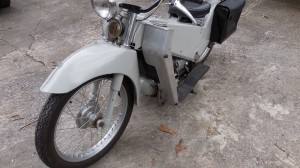
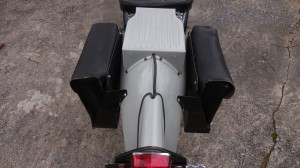
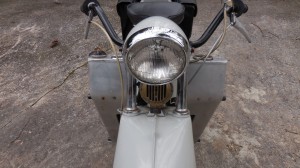
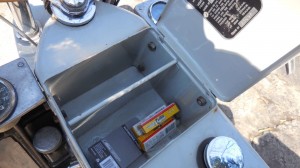
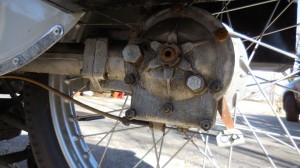
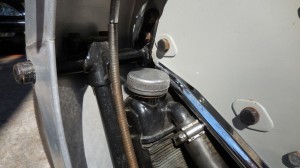
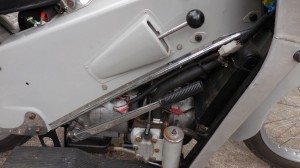
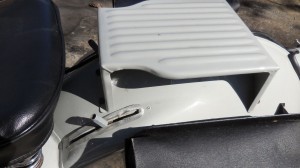
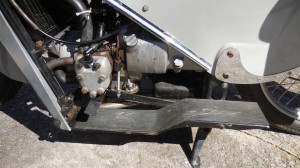

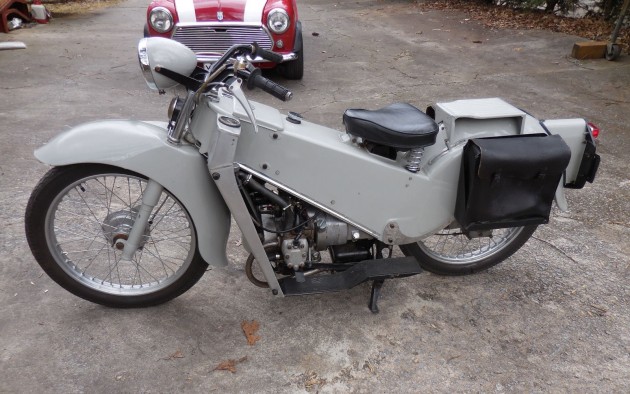


The longer lever is a hand start which is quite easy to use, the shorter is the gearshift. I have one of these and it is a great little bike even if grossly underpowered. It uses a monocoque pressed steel frame which was actually ahead of it’s time.
By the way ,The other what you call levers by the rear rack are actually the top of the shocks . You slide them back or forward in the slots to vary your ride height according to your load. This was a feature on many Velocettes.
I’m going to try my hardest not to bid on this bike, but I can’t guarantee anything. This sort of thing is right in my sweet spot, I love anything unusual.
In England these are quite common and don’t command a high price yet. So do your shopping in England. I have a foot change, 4 gear Mk III. I had a hand change three gear MkII. These are 200cc. Never buy the early MkI 150cc as they are just too low on power. Ride is very comfortable and handling really good. Don’t compare with Japanese as these were first produced in the late 1940’s. Over engineered and under powered with engines that last forever compared to air cooled parallel twins. If they had made them 250cc (max size for learners over here) and a bit more powerful they would have been a winner. road worthy about 1500USD very good condition rarely over 2500USD.
We used to call the ‘Noddy Bikes’ – no idea why. I used to get stopped regularly by coppers riding these low slung bikes. Very quiet engine – which is probably why the police used them to creep up on villains!
I think the police (coppers) would nod to acknowledge each other, hence noddy bike. The LE comes from the word siLEnt. The club magazine is called On The Level. Mainly we think, because the LE does not like hills.
LE is actually for Little Engine.
The term “Noddy” refers to what the motorcycle officers were allowed to use as an alternative to saluting when in motion. They would nod at a superior so that they did not have to remove a hand from the controls. It was about safety.
If Pee-Wee Herman rode a motorcycle. I can just see a group of these guys getting stopped by one of these. ( calm down, Scotty, that price would buy a nice ’57 Rambler Rebel) :) https://s-media-cache-ak0.pinimg.com/236x/f6/af/04/f6af04872f7089d36c5ace642a14761b.jpg
Thanks for the laugh Howard. In the late 70’s, early 80’s some of us would moonlight at the Honda dealer in town setting up the new bikes. Mostly the scooters. Fridays were the highlight when we would test drive them. Pretty funny seeing four or five guys riding the scooters as most of us kind of looked like your posted photo! Great times!
I think that this bike is worth a couple of times what the current bid is, Howard, maybe we could go halfsies on it – my high bid didn’t last too long. Could you imagine riding this baby to Sturgis? Your last ride.. ever..
Thanks Barry, I’ve always wondered where ‘Noddy’ came from. Can you shed any light on the expression ‘Old Bill’?
‘Old Bill’ is British slang for ‘police officer’.
Bob
Too many explanations for ‘The Old Bill’. Nothing concrete.
It’s a collective noun, and yes – refers to Police in general. Just wondering how it originated. ‘Bobbies’ is an easy one (from Robert Peel), Coppers??? (Cops in US?), but -interestingly I don’t think I’ve ever heard an Englishman use the term ‘Rozzers’.
The term Copper was the original, unshortened word, originally used in Britain to mean “someone who captures”. (In British English the term Cop is recorded (Shorter Oxford Dictionary) in the sense of ‘To Capture’ from 1704, derived from the Latin ‘Capere’ via the Old French ‘Caper’).
Brilliant – that makes sense.
The term “Copper (s) is derived from when the police officers began wearing badges over their hearts which were originally made of copper as a protective device.
Wow, that is interesting – was this in USA?
The 3 crazy “presenters” on the BBC show Top Gear used the term “Rozzers” on a regular basis.
They would!
What interesting little bikes these are. I’m going to probably piss someone off here by suggesting the basic concept of these machines was borrowed from several German makes and not something conceived of out of thin air. If you have a look at NSU (who had been building pressed steel framed bikes since the 30’s), Adler, Zuendapp (can’t find any umlauts on this keyboard) and of couse, the WWII BMW’s. Both Zuendapp and BMW had opposed cylinder engines, but the water cooling thing with dual driveshafts really IS unique. My favorite moncoque frame bikes have to be the NSU Max and the Austian Steyer-Puch though; the flowing lines seem much more pleasing than the angular Velo design. I lived in Neckasulm in the mid-60’s while in the US Army, directly accross the RR tracks from the NSU factory. There was a scrapyard in town that had a row of NSU bikes going back to the late teens – all for sale at absurdly low prices. I could have bought a Super Max Police model, one of 30, in like new condition for DM 400, or $100. US. There were also 2 German Triumphs, a Horex, 3 BMW Autobahn Police R 69’s and on and on….
Greetings All,
Dave, not bustin’ you, but is there another company named Zuendapp, along with Zundapp, or did the spelling get Americanized for us?
There was one Zuendapp company. We spelled it “UE” because our keyboards don’ include an option for putting umlauts over letters. At least mine doesn’t.
On Windows machines you can reset to other languages and alphabets. Mein guter freund gut Deutch sends me emails all the time with that. Also English Pound symbols. Arabic, Persian, whatever you want. Wusel is from Westfallia region and they have their own dialect and slang so even regular Germans sometimes dont understand.
Dr. Wusel does a comic strip and has a book out “Deppen Mussen Draussed Bleiben!!” (only the cool kids allowed) filled with Biker and adult humor. He gave one to a tow truck driver in the US who rescued him and his broken down Barn find truck
(65 Chevy panel delivery) after he gave it to him the driver told him he was going to give it to his kid to take to school as he was learning German in School, #Faceplant# Some of the language, and themes were rather adult in nature. Was ist denn mit der los?
I was also stationed in Germany in the early half of the 1970s, and a local junkyard in Swetzigen [near Heidelberg] had many early post war cars in it, all were mostly complete as the owner was more of a hoarder than scrapyard operator. Vehicles included dozens of microcars, plus 3 VERY early Volkswagens, All British built, 2 with RHD. The LHD version had cable brakes, no back seat & no bumpers. He said it was a “Farmer’s version”.
I was unable to get the yard owner to sell complete cars, so I bought many emblems and small items. I had made friends with him by showing my scrapbooks of the cars I owned back in the USA. He loved pre-WW2 cars. He had a 20 liter wooden bucket filled with the keys to all the cars he brought into the yard since 1945, and I was able to buy the entire bucket, that cost me a whopping 5 DM [about $2.] When I returned again in 1996, the yard was long gone. Until last year I still had the VW emblems including the solid VW badge at the base of the windshield, but sold them at the AACA Hershey flea market. I still have rare & unusual keys & emblems from that yard, including the 1950s Opel key fobs with the hidden key inside! [I’m always at Hershey spaces RSA 7 to 11 in October!]
Kamarad! You too, eh? I look back on that time with nothing but good memories and some major regrets at not having been persistent enough in parsuading my car collector father to bankroll my buying of a number of great machines to ship and sell in the States. I had a new Fiat 850 Sport Coupe that I tooled around the countryside in with my German girlfriend (later my first wife), and one day found a BMW 328 roadster sitting beside the road in a local village. It was in excellent original condition and looked like it was a daily driver. After calming down, I had my girlfriend write a note asking if the owner might be interested in trading for a new Fiat. (Sure!) 3 days later I had a letter from the guy who said YES! I actually pinched myself. He was a really great guy with an equally great small family who had inherited the car from his father. It had no war wounds and about 30,00 km on the clock, having spent the entire war in a safe village barn. On the day we were to make the trade, he called and told me in a very pained and apollogetic way that he had to not go through with it> :( This was because he had promised his 8 year old son the car when he was old enough to drive and his son was having a breakdown over the prospect of losing it. Even though I was beyond disappointed, I couldn’t fault the owner for being a good dad.
Ah yes……….4 DM to the dollar and 1 DM beer
Was ist hier loss? I theoretically switched over to a German keyboard, but all that happened was a loss of functionality. Supp widat? Menches kinder!
Although the LE is a pressed steel body it is largely open on the underside. There is a proper sub-frame that holds the engine, rad etc. attached near the top yoke. Horizontally opposed twin cylinder water cooled side valve with a shaft drive on one side. Adjustable damping on the rear. Thousands sold as police bikes with a single seat and a flat shelf on the pillion area for the radio. 50mph top speed. Not as many sold to the public but these often had a dual seat. Everything well engineered and long lasting hence loads of them survive. Good spares service so a very practical purchaase – don’t pay an arm and a leg though.
Greetings All,
These seem to come up for sale every now and then. Reminds me of the early Triumph Twins that had the carbs and everything behind the cylinder head covered with a metal stamped shroud, which everyone promptly took off and threw away, much to the dismay of the people restoring these years later.
I thought there was a connection to Adler. Velocette was in its final death throes by this time. Don’t believe they had anything to do with the engine. Thought the unconventional design was due to Velocette making due with what limited funds, tooling and manpower they still had at the time.
It’s too bad that the big Velos went away. They made some of the nicest motorcycles in the world at one time, but isn’t that the way it goes with so many great machines?
Hi guys. Everytime I see the name, Velocette, I think of the Thruxton 500. Nice bike; extremely difficult to start at times but well worth the ride when you got it lit. I sure wouldn’t mind having one of them…
Triumph – Called ‘Bath Tubs’ over in England.
The ‘Silent LE.’ It was always an unusual-looking bike but it sold in reasonable quantities in the fifties. I actually got a parts book and manual for one of these; it was in a box of motorcyle stuff I got from a dealer in the Pacific Northwest about 45 years ago. I never knew a motorcycle like this existed until I got the books….
The last Velocette LE police bike in service was used up until 1974 by the UK’s Metropolitan Police Service for the purpose of delivering court papers in London.
Learnt this bit of information just a few weeks ago via my local Police on Twitter!
Not a weird bike at all, I suppose to an American they are, but theres a big wide world out there. Matt Tritt is correct, the Germans really developed the pressed steel frames. I had an NSU for a while, Now THOSE are an amazing bit of kit. The Supermax is the one to have, looks like a 2 stroke but is a 4 stroke, revs to 12,000 rpm and were serious contenders back in the day. The English dabbled in the pressed steel frames. If you want a WEIRD bike, then look at the Ariel leader. The Japanese copied the Germans and English and of course took it to a new level.
I went and looked at a shop/barn full of Velos last Saturday. Might be a bit too high, but they are rare in the US but more in demand in old Blighty which is a guy over there I was evaluating the bikes for. He ships containers from the US to there. There was Venoms, KSS and Thruxtons. Various conditions.
If you lads want to don your winklepickers and wellies, then head on down to San Jose for the Annual and holy days of Mecca, The Clubmans show. April 2nd. Founded by the BSAOC of NorCal, the Triumph Club, Norton Club, Matchless & AJS Club, Ariel Club, Velocette Club etc etc hold their annual gathering with a morning after ride as well. WIN a BSA B50 for $1 in the raffle! Swap meet, bike show, vendors. Then hang out at Rabers. (They serve beer). Stop by my booth at the show. Look for Maggie Neato, Sassy Lass and spokes model for Norton America Motorsports. Might be a bird tussle with the Maggie Neato of the BSAOC as well. Might be a showing of Mrs Peel as well
If you think the LE is not that different, Velocette developed other small machines. The air cooled version of the LE, the OHV Valiant, was a great lightweight and a bit faster. Unfortunately still only 200cc so did not tempt the 250cc learner market. Well made and expensive.
Then came the Velocette Vogue. Almost the same as a MkIII LE underneath, pressed steel replaced by plastic and only 50mph just the same. Less than 3,000 of these made so nice to have in the shed.
And the cherry on the cake was the Viceroy Scooter. Horizontally opposed twostroke twin. Too late to arrive on the scooter scene and far too ugly and expensive. Everything a motorcycle manufacturer thought a scotterist would want but without style. http://velobanjogent.blogspot.co.uk/2008/04/from-viceroy-scooter-to-small.html
Hi BF, These LE Velocettes aren’t strange, or unique. For something different, how about a Megola, with the 5 cylinder radial built inside the front wheel, a Ner-a-car, or, a Bohmerland. Now that’s different!
Uh-oh. I wanted badly to attend the meet in Norcal (last year?, I forget) and now it’s too far South! Bugger. Love the Velo in the pic! I’ve owned 2 Bonnevilles and a Francis Barnett – and a G-50 Matchless – and a CZ and Bultaco Matador; all of which now are entirely too valuable to ride. The Franny-B maybe not so mutch.
I restored a Francis Barnett Cruiser Twin 250 a couple of years back. Didn’t enjoy it too much – not really a great 2 stroke fan. Still, customer was reasonably happy.
Ill take that G-50 off your hands gladly! Nonsense on too valuable to ride (maybe to work everyday) but ride ’em dont hide ’em! Ive got a 1948 Famous James (Rigid frame) with mighty 98cc Villiers motor so i can hang with the hipsters and their scooter clubs locally. They are in awe of such ancient Iron.
But tell you what, If you cant make the Clubmans show in San Jose then plan your calendar for the International Norton Owners (wankers) Club national rally. This year up in some stunning scenery in the hills of Northern California near Quincy. ALL British bikes are welcome! I am planning to attend, and will be giving some tech sessions on the VR880 and the Norton America bikes as well as a display. Some of the original Norton factory staff will attend including an engineer who developed the Isolastics and then went on to work for Harley and developed THEIR vibration isolation designs (Along with Eric Buell) think FXR. I am trying to get some of the design and tech guys from Norton America to attend, and we invited Stuart Garner. Current owner of the Norton name in the UK and producer of the modern Nortons.
For a little more eye candy, Heres another bike I evaluated Saturday. A few bits & Bobs are off of it at the moment but they are there. Very cool bike that raced at the Isle of Mann, a 1936 500cc Excelsior Manx TT. “Lemme a few Quid” (Lemmy RIP) and ill buy it and bring it to some of the shows. Id put a Brooklands can on it and fire it up.
Very cool Manx logo on the 1936 Excelsior Manx TT. If you lads dont know about the isle of man, do your research.
Top of the Overhead Camshaft drive. No rest ’till the TT, Do the ton!
Wow. How I miss the time when British bikes were on top of the world! If you want a good fright, watch a few of the recent Isle of Man rider videos on youtube.
I remember being given a lovely Velocette 350cc (Viper?). It came with a Watsonian side-car – which I very quickly detached. It had a single seat with springs and ‘Fish Tail’ exhaust. No memory of what happened to it!
Ha Ha, I was once offered an partially dismantled Aerial motorbike for free – so went to have a look to see what it was. To my horror it was a ‘Leader’!!! I made my excuses – and ran away very quickly. Funny that now we find it rather attractive (in a quirky sort of way).
There was an article in Classic Bike magazine some years back. Called “Testing times” and was an interview of a factory tester who told all kinds of tales about bikes being tested and evaluated. He was unfortunate to have been stuck for a while on the Ariel Leader program. He had a LOT to say about those foul beasts! At one point he lost control of one and it tossed him in a canal, He was just crawling up the embankment (Cursing no doubt) when a Mgr came by on his way to work. Basically Mgmt didnt want to know anything negative. Quite a tale. Some years back, Cliff Mahjor, Aka The Sandy Bandit owned the entire warehouse inventories of all the now closed british bike US distributors. (JOMO, Valencia, TriCorp, NVT, etc etc) He bought ALL the warehouses over the years. Then it all went up for sale. Somewhere i have pictures of semi trailers and shipping containers packed with NOS parts and New bikes in the crates. Among them, was several NOS Ariel Leaders still in crates. Someone bought them, might be fun display items i guess.
Actually, In “Weird” motorbikes, this is a deviation from Motorbikes entirely but Vincent (makers of the HRD Vincent cycles of Black shadow, Rapides & Comets) built the worlds very first watercraft. Before there was Jet skis and wave runners. Great idea and came out in the 1950s. One article I read in Classic Bike magazine recounted how a press showing went very very badly when demonstrating the watercraft it seems someone miscalculated and while just fine in Jolly old England, the exhaust was too close to the fiberglass enclosure and overheated in the US demo and caught fire and sank and the demo rider had to be rescued. Heres a link to an article thats also very interesting and more history and interview with the designer. See:
http://www.motohistory.net/news2009/news-mar09.html
the Amanda was produced by Vincent in 1957 and ‘58 after the company had ended production of its famous V-twin motorcycles. Amanda was the world’s first “personal watercraft”—the predecessor to today’s JetSkis and Wave Blasters. It was named for the daughter of British businessman E. Werner, who brought the concept to Philip Vincent. The forward-thinking Vincent sensed the opportunity and assembled a team to develop the craft. Smith at the time was a young design draftsman who had joined Vincent in late 1951 after his first job at aircraft enginemaker Napier.
he Amanda development program was rushed, according to Smith—roughly six months from drawings to prototype in late 1956. The initial prototype, nicknamed “The Whale,” appeared ready for testing and early demonstrations on a lake near London failed to show any major problems. Philip Vincent was said to be very encouraged with the Amanda’s performance; the T20 model would get up on plane quickly and was capable of 28 mph.
But lurking in this pioneering craft was an Achilles’ heel—the polyester resin used in the hull material. Sourced from the Bakelite Resins Co., the resin used in the first batch of production hulls was thermally unstable. The troubles didn’t surface until the Amanda landed in the U.S. Vincent had struck a deal with an American distributor based in Wausau, Indiana, who ordered 200 Amandas (worth £500,000, noted newspaper reports) in June 1958. The distributor was ahead of his time, realizing the vast U.S. could be a huge market for a zippy “water scooter.” According to a report in Britain’s Evening Standard, the American sales agent planned to order 6,000 more Amandas pending acceptance of the first batch.
But disaster struck the first time the Amanda was demonstrated on a U.S. lake. It was a hot, sunny day, and as the engine heat rose, the combined ambient and engine thermal loads caused the plastic surrounding the engine house to sag, then collapse. Everyone watching on shore, including the press, saw the rider sink slowly beneath the waves to become a swimmer, right before their eyes. Sunk with him was the public image of Vincent’s latest sporting machine.
Tragedy in the Amanda saga doesn’t end there. Veteran Vincent employee and factory tester Johnny Penn drowned while testing an Amanda near Mersea Island, off the Colchester coast. The craft Penn was riding was found adrift three months later, according to contemporary press reports. Penn was the second Vincent tester to die in the line of work, Henry Pennington having perished on a Black Shadow near the Watford by-pass.
When the U.S. demo debacle occurred, Vincent’s trusted “right hand man” Ted Davies was already in the States on company business. He went straight to Wausau to investigate the problem.
“Based on Ted’s appraisal, we determined the hull needed internal reinforcing—perhaps a tubular frame,” recalled Roy Smith. But that was the Amanda’s legacy: The original idea was fantastic, but the product was not thoroughly tested and developed before it was ready for market.
Today, Amandas in “water-worthy” condition are scarce. When I wrote a feature on Smith and the Amanda for Classic Bike magazine in 1995, editor Philip Tooth then knew of only a few examples in Britain. It is unclear how many were shipped to the U.S., which would’ve likely been the craft’s largest market.
–Lindsay Brooke
Great story! My father was an early pioneer in fiberglass boats, spars and auto bodies (Glasspar), and had to work with quirky resins as well. This was because of chemical shortages due to the Korean conflict. He ended up using polyester resins made by the Naugatuck Chemical Company, which turned out to be quite good. Judging by the amazing number of Glasspar boats from the late 40’s and both cars and boats from the early 50’s still in active use, I’d say that they had the formula down pat. Still, allowing sufficient distance between body and exhaust parts seems like a good plan!
My father bought one of these for me (in England) at a Police surplus auction in 1965 for £15 (about $22?) and I loved it, driving it the 18 miles to work and back every day until the shaft drive failed and I could not afford the replacement part. It was very comfortable and vibration free but no use in snow as the lower part of the fairing caused the bike to rise above the snow, robbing me of traction. Second only to the Velocette Mac that I later had, it was my favourite bike. I miss them almost as much as my hair.
Just how I feel about my bikes and hair. If I could do it over again I’d keep both.
The USA Velocette LE is way too high. Looks like we should send a container full of them to you from England.
http://www.ebay.co.uk/itm/301893317706?_trksid=p2060353.m1438.l2649&ssPageName=STRK%3AMEBIDX%3AIT
You are correct Barry, That one you just posted a link to is very attractive with the British Racing Green color. That really is a good color choice for that bike.
I need to ship my 1932 BSA over (currently in Scotland) so if someones packing a shipping container and wants to share costs let me know.
I know one chap in USA who buys microcars in Europe. Plenty of room in his container. Will find out where he lives. I have never exported. Friend brought a Desoto into the UK. I wonder how much a container costs to USA.
T,he L.E.Velocette was the first motorbike I owned and learned to ride,its reg.no,was H J W 9 4 3.This was in 1956 I had it for 3 years and then went on to larger and more powerful bikes.I sold it in May 59 for the same price I paid for it which was £40.The L.E. meant little engine. It was a nice bike to ride apart from icy roads you could soon find your self on your bum.I even went halfway up Snowden[A mountain in Wales] in July 1958 When a friend and I went camping.Happy days.
I have a small collection of Brit bikes that I will soon be offering for sale as I no longer ride.